AMD's 65nm Brisbane Core Previewed: The most energy efficient AMD CPU to date
by Anand Lal Shimpi on December 14, 2006 6:08 PM EST- Posted in
- CPUs
Media Encoding Performance & Power Consumption
In the interest of time we skipped our general application suites (SYSMark/Winstone) and dove directly into the individual application benchmarks to give us a more direct idea of how AMD's new 65nm chips will fare. We start off with our Windows Media Encoder test:
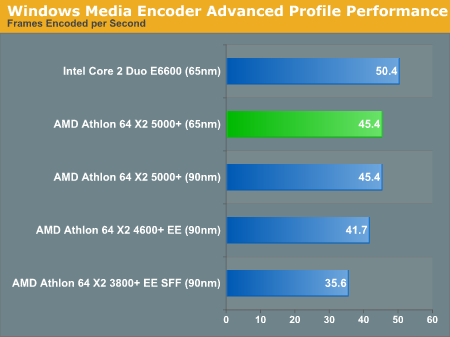
At the same price point, Intel is still faster with the E6600 as we've seen in the past, but what we're here mainly to do is to compare power usage, so let's see how Brisbane stacks up.

Power consumption is down from 90nm, as the 65nm system used about 15 fewer watts than its predecessor. The move to 65nm actually brings AMD in line with the power consumption of Intel's Core 2 Duo E6600, but it is still not enough to best the EE and EE SFF chips, the latter of which is rated at a cool 35W TDP.
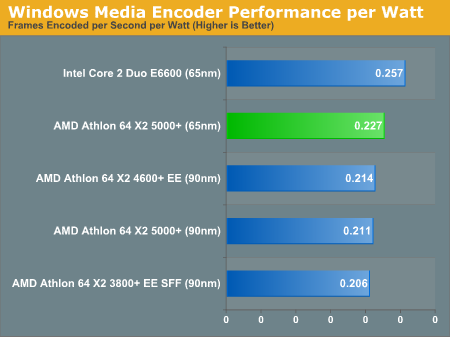
Performance per watt is a different story; although AMD can compete with Intel in terms of power usage, it will take a new architecture to close the performance gap and thus performance per watt suffers in comparison to Core 2 Duo. The good news is that if we just look at the AMD CPUs in the performance per watt chart, it looks like the new 65nm processor offers better performance per watt than anything else in AMD's lineup - even the EE/EE SFF CPUs.
Moving on to our DivX test we see more of the same: the performance lead clearly goes to Intel's Core 2 Duo E6600:
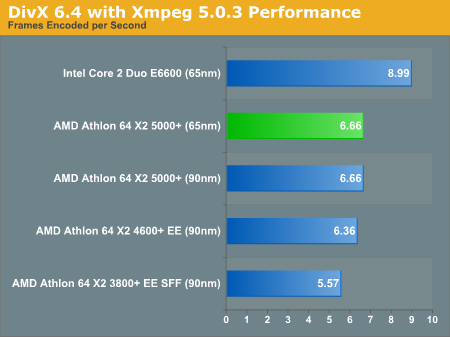
Power usage is actually slightly lower on the 65nm AMD system than on the Core 2 Duo platform, and a bit lower than the 90nm X2 5000+ setup. The difference between 90nm and 65nm isn't huge here, a matter of just under 10W, but hopefully it's merely a sign of an early 65nm process compared to a more mature 90nm process.
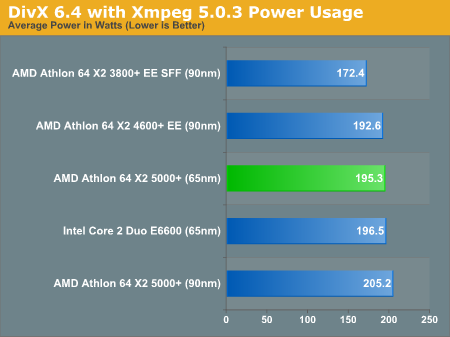
The performance per watt crown still belongs to Intel, but if you look at AMD alone, Brisbane offers better efficiency than anything else in AMD's lineup.
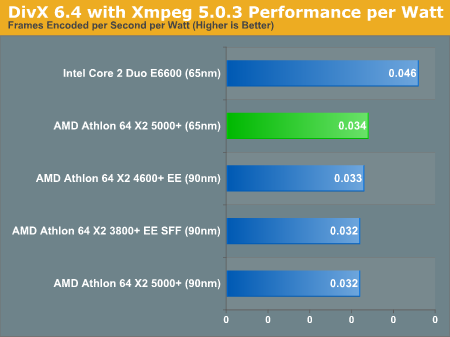










63 Comments
View All Comments
Live - Thursday, December 14, 2006 - link
It does not use more power then any other chip except the 90nm X2 5000+. Where did you get that from? Did you read the article?Stereodude - Thursday, December 14, 2006 - link
Yes, I read the article. Excluding the C2D it uses the 2nd most amount of power, basically tied with the 65W 4600+.smitty3268 - Thursday, December 14, 2006 - link
Not all the power that goes into a chip is released as heat. The heat is basically wasted power that "leaks." So if a chip can get more useful work out of the same amount of power then the amount of heat released would decrease even while power consumption remained steady.I'm not an expert, but I believe a lot of the special new process techniques we always here about (like strained silicon) basically just reduce the amount of wasted energy. Am I right here?
Stereodude - Thursday, December 14, 2006 - link
Sorry, but that's incorrect. All the power is turned into heat. The power can't be going anywhere else. Power in = Power out.It's not like a LED where you get some energy out as light, or a motor where you get mechanical energy out of it in addition to heat.
finalfan - Thursday, December 14, 2006 - link
If all the power can be turned into heat then it will be the most efficient heater the human being ever built. And even greater, you get all the computation done for free. Could you believe that?Stereodude - Thursday, December 14, 2006 - link
Where else is the energy going if it isn't getting turned into heat? You apparently don't have any idea how the transistors in a processor work.splines - Thursday, December 14, 2006 - link
You apparently don't have any idea about basic thermodynamics.If the processor released all of its energy in heat, it'd be the world's most efficient space heater.
You have forgotten a few little points, like that work is done by a processor (wouldn't be much point otherwise). Transistors are switched, mostly, however the IC itself can expand and contract, as well as the packaging material. The heat generated by a CPU is because of the resistance inherent to the circuits. All of the above is considered energy expended (or, more properly, changed in state).
In other words, don't go around insulting people's intelligence when you don't know yourself what you're on about.
Stereodude - Thursday, December 14, 2006 - link
I'm betting only one of us has an Electrical Engineering degree, and guess what... You're not the one with it.The work being done by the CPU is what makes the heat. The transistors themselves create heat because they consume power, and a lot of it, to switch from one state to another at high speeds.
I will say it again since you still don't get it, though it probably won't help. Energy is conserved. Electrical energy goes in, and heat comes out. The thermal expansion and contraction of the part isn't work. It's a side effect of the heat being product when the transistors consume electrical power by switching and make heat.
slayerized - Friday, December 15, 2006 - link
Thermodynamics 101- First law of thermodynamics: “Energy can neither be created nor destroyed, it can only be converted from one form to another” (Power --> Heat)smitty3268 - Friday, December 15, 2006 - link
I think everyone here knows that, the issue is that current -> heat is not the only type of transformation that can occur. If it was then anything electric wouldn't be able to do anything at all except create heat, and obviously that isn't true.